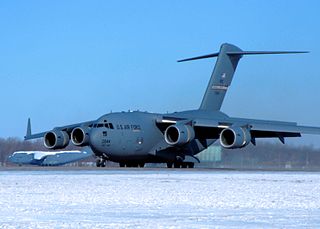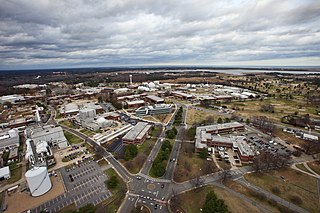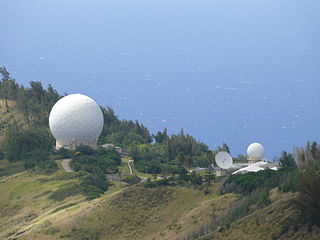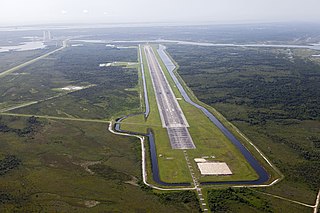
The Space Shuttle is a retired, partially reusable low Earth orbital spacecraft system operated from 1981 to 2011 by the U.S. National Aeronautics and Space Administration (NASA) as part of the Space Shuttle program. Its official program name was Space Transportation System (STS), taken from a 1969 plan for a system of reusable spacecraft where it was the only item funded for development.

Edwards Air Force Base (AFB) is a United States Air Force installation in California. Most of the base sits in Kern County, but its eastern end is in San Bernardino County and a southern arm is in Los Angeles County. The hub of the base is Edwards, California. Established in the 1930s as Muroc Field, the facility was renamed Muroc Army Airfield and then Muroc Air Force Base before its final renaming in 1950 for World War II USAAF veteran and test pilot Capt. Glen Edwards.

The George C. Marshall Space Flight Center (MSFC), located in Redstone Arsenal, Alabama, is the U.S. government's civilian rocketry and spacecraft propulsion research center. As the largest NASA center, MSFC's first mission was developing the Saturn launch vehicles for the Apollo program. Marshall has been the lead center for the Space Shuttle main propulsion and external tank; payloads and related crew training; International Space Station (ISS) design and assembly; computers, networks, and information management; and the Space Launch System. Located on the Redstone Arsenal near Huntsville, MSFC is named in honor of General of the Army George C. Marshall.

Grand Forks Air Force Base (AFB) (IATA: RDR, ICAO: KRDR, FAA LID: RDR) is a United States Air Force installation in northeastern North Dakota, located north of Emerado and 16 miles (26 km) west of Grand Forks.

Wright-Patterson Air Force Base (WPAFB) is a United States Air Force base and census-designated place just east of Dayton, Ohio, in Greene and Montgomery counties. It includes both Wright and Patterson Fields, which were originally Wilbur Wright Field and Fairfield Aviation General Supply Depot. Patterson Field is approximately 16 kilometres (10 mi) northeast of Dayton; Wright Field is approximately 8.0 kilometres (5 mi) northeast of Dayton.

STS-3 was NASA's third Space Shuttle mission, and was the third mission for the Space Shuttle Columbia. It launched on March 22, 1982, and landed eight days later on March 30, 1982. The mission, crewed by Jack R. Lousma and C. Gordon Fullerton, involved extensive orbital endurance testing of the Columbia itself, as well as numerous scientific experiments. STS-3 was the first shuttle launch with an unpainted external tank, and the only mission to land at the White Sands Space Harbor near Alamogordo, New Mexico. The orbiter was forced to land at White Sands due to flooding at its originally planned landing site, Edwards Air Force Base.

White Sands Missile Range (WSMR) is a United States Army military testing area and firing range located in the US state of New Mexico. The range was originally established in 1941 as the Alamogordo Bombing and Gunnery Range, where the Trinity test site lay at the northern end of the Range, in Socorro County near the towns of Carrizozo and San Antonio. It then became the White Sands Proving Ground on 9 July 1945.

The Langley Research Center, located in Hampton, Virginia near the Chesapeake Bay front of Langley Air Force Base, is the oldest of NASA's field centers. LaRC has focused primarily on aeronautical research but has also tested space hardware such as the Apollo Lunar Module. In addition, many of the earliest high-profile space missions were planned and designed on-site. Langley was also considered a potential site for NASA's Manned Spacecraft Center prior to the eventual selection of Houston, Texas.
Lockheed Martin Space is one of the four major business divisions of Lockheed Martin. It has its headquarters in Littleton, Colorado, with additional sites in Valley Forge, Pennsylvania; Sunnyvale, California; Santa Cruz, California; Huntsville, Alabama; and elsewhere in the United States and United Kingdom. The division currently employs about 20,000 people, and its most notable products are commercial and military satellites, space probes, missile defense systems, NASA's Orion spacecraft, and the Space Shuttle external tank.

Selfridge Air National Guard Base or Selfridge ANGB is an Air National Guard installation located in Harrison Township, Michigan, near Mount Clemens. Selfridge Field was one of thirty-two Air Service training camps established after the United States entry into World War I in April 1917.

Kaena Point Space Force Station is a United States Space Force installation in Kaena Point on the island of Oahu in Hawaii. It is a remote tracking station of the Satellite Control Network responsible for tracking satellites in orbit, many of which support the United States Department of Defense, receiving and processing data and in turn, enabling control of satellites by relaying commands from control centers.

The Shuttle Training Aircraft (STA) is a former NASA training vehicle that duplicated the Space Shuttle's approach profile and handling qualities, allowing pilots to simulate Shuttle landings under controlled conditions before attempting the task on board the orbiter. The STA was also flown to assess weather conditions just prior to Space Shuttle launches and landings.

Space Launch Complex 3 (SLC-3) is a launch site at Vandenberg Space Force Base that consists of two separate launch pads. SLC-3E (East) was used by the Atlas V launch vehicle before it was decommissioned in August 2021 with the final launch taking place on November 10, 2022 at 09:49, while SLC-3W (West) has been demolished.

The Shuttle Landing Facility (SLF), also known as Launch and Landing Facility (LLF), is an airport located on Merritt Island in Brevard County, Florida, United States. It is a part of the Kennedy Space Center and was used by Space Shuttle for landing until July 2011. It was also used for takeoffs and landings for NASA training jets such as the Shuttle Carrier Aircraft and for civilian aircraft.

The Space Shuttle orbiter is the spaceplane component of the Space Shuttle, a partially reusable orbital spacecraft system that was part of the discontinued Space Shuttle program. Operated from 1977 to 2011 by NASA, the U.S. space agency, this vehicle could carry astronauts and payloads into low Earth orbit, perform in-space operations, then re-enter the atmosphere and land as a glider, returning its crew and any on-board payload to the Earth.

The Neil Armstrong Operations and Checkout Building (O&C) is a historic building on Merritt Island, Florida, United States. The five-story structure is in the Industrial Area of NASA's Kennedy Space Center. Its has twin-block facilities that include the crew quarter dormitories for astronauts, suit-up preparations prior to their flights, and the other is a large spacecraft workshop used for manufacturing and checking activities on crewed spacecraft. On January 21, 2000, it was added to the U.S. National Register of Historic Places.

NASA's Christopher C. Kraft Jr. Mission Control Center, also known by its radio callsign, Houston, is the facility at the Lyndon B. Johnson Space Center in Houston, Texas, that manages flight control for the United States human space program, currently involving astronauts aboard the International Space Station (ISS). The center is in Building 30 at the Johnson Space Center and is named after Christopher C. Kraft Jr., a NASA engineer and manager who was instrumental in establishing the agency's Mission Control operation, and was the first Flight Director.

The Mercury Control Center provided control and coordination of all activities associated with the NASA's Project Mercury flight operation as well as the first three Project Gemini flights. It was located on the Cape Canaveral Space Force Station, east of Samuel C. Phillips Parkway.

The Stanley R. Mickelsen Safeguard Complex (SRMSC) was a cluster of military facilities near Langdon, North Dakota, that supported the United States Army's Safeguard anti-ballistic missile program. The complex provided launch and control for 30 LIM-49 Spartan anti-ballistic missiles, and 70 shorter-range Sprint anti-ballistic missiles.



















